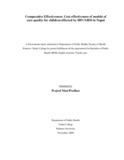Please use this identifier to cite or link to this item:
https://hdl.handle.net/20.500.14356/810Full metadata record
| DC Field | Value | Language |
|---|---|---|
| dc.contributor.author | Pradhan, Prajwal Mani | |
| dc.date.accessioned | 2012-12-28T22:39:27Z | |
| dc.date.accessioned | 2022-11-08T10:21:11Z | - |
| dc.date.available | 2012-12-28T22:39:27Z | |
| dc.date.available | 2022-11-08T10:21:11Z | - |
| dc.date.issued | 2009 | |
| dc.identifier.uri | http://103.69.126.140:8080/handle/20.500.14356/810 | - |
| dc.description.abstract | U.S. federal government in its official site www.Recovery.govdefines comparative effectiveness as “Research that compares the clinical outcomes, effectiveness, and appropriateness of items, services, and procedures that are used to prevent, diagnose, or treat diseases, disorders, and other health conditions recovery” which is in close align to American Recovery and Reinvestment Act, 2009. Cost-effectiveness analysis (CEA) is a form of economic analyses that compares the relative expenditure (costs) and outcomes (effects)of two or more courses of action. Cost-effectiveness analysis is often used where a full cost-benefit analysis is inappropriate e.g. the problem is to determine how best to comply with a legal requirement. (Wikipedia, 2009). 15 million children worldwide have already been orphaned by HIV/AIDS by the year 2007 (UNAIDS, 2008). Nepal has concentrated epidemic of HIV/AIDS. The national prevalence level of HIV/AIDS is at 0.5% (UNAIDS, 2008). It is estimated that currently 70,000 people are living with HIV/AIDS in Nepal (UNAIDS, 2008). It has also been estimated of 5000 deaths in adults and children as of 2007 whose low and high estimates are 3500-7500 (UNAIDS, 2008). This concentrated epidemic still seems to be concentrated in the age group of 15-49 year age group. The disability and death of the people of this age group has tremendous impact on the lives of children. Orphan and Vulnerable children refer to those children under the age of 15 who has lost his/her biological parent both or one of them due to HIV/AIDS and now are/is currently either living with or without HIV/AIDS but is prone to stigma, discrimination and disregarded by society. Children account for half of all the new HIV infections worldwide and it is estimated that approximately four thousand children in Nepal are infected with HIV. With an estimated seventy thousand people living with HIV in Nepal, there are tremendous implications for children, whose lives are greatly affected when a parent is infected (UCAAN, 2007). The purpose of the study was to conduct cost-effective analysis for models of care for orphaned and vulnerable children in Nepal The study dealt with cost (fixed, semi-fixed, variable, medical costs) and child care months as variables of the study whereas convenient sampling was used for the sampling process. The sample size was at least one site for each model of care that exists in Nepal at the time of the study, should be functional for at least one year (see sample specification). Data was collected by using informal interpersonal communication, and sometimes few semi-structured questions and observational checklist. Financial costs were processed into economic costs for analysis using simple economic tools like opportunity cost, discounting, and annualization. The minimum standard of care was adapted from the minimum standard of care for conduction of child care home, 2060 B.S., Central Child Welfare Board. The child care models though are many in number for orphan children but not much for children with HIV/AIDS or for orphan and vulnerable children. The existing models of care range from community based care model to improvised form of home based care model or comprehensive care model. Keta-keti Ashram’s cost of care was 9,215.44(with house rent), 1,53,804.51 (with house ownership) per child, Manisha Singh Punerjeevan Niwas (MSPN)’s cost of care was 8,666.97(with house rent), 1,53,756.04(with house ownership) and Aakura 5402.17(with house rent), 1,53,249.24 (with house ownership). The reasons for the variations in cost can be attributed to multitude of factors ranging from cost of supervision to cost of placement. Cost also varies according to the model of care with the most cost effective to be community based care (with income generation activities). It is also essential to view that though community based care is the most cost effective child care model it may not always be sufficient in addressing all the needs of children. Therefore, it is always important to keep space for other child care models which provide or specialize in particular child care modes. | en_US |
| dc.language.iso | en_US | en_US |
| dc.subject | Comparative effectiveness | en_US |
| dc.subject | Cost-effectiveness | en_US |
| dc.subject | CABA | en_US |
| dc.subject | OVC | en_US |
| dc.subject | Care models | en_US |
| dc.title | Comparative Effectiveness: Cost-effectiveness of models of care quality for children affected by HIV/AIDS in Nepal | en_US |
| dc.type | Technical Report | en_US |
| Appears in Collections: | Post Graduate Grant (PG) Reports | |
Items in DSpace are protected by copyright, with all rights reserved, unless otherwise indicated.

